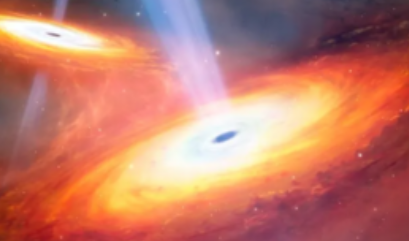Time to geek out on some massive black holes and supernovas happening
Astronomers are witnessing an unprecedented spectacle in the cosmos: the awakening of a supermassive black hole at the center of a distant galaxy. In late 2019, a team noticed a sudden spike in brightness in the otherwise unremarkable galaxy SDSS1335+0728, located 300 million light-years away in the Virgo constellation. This increase in brightness was automatically detected by the Zwicky Transient Facility’s telescope at the Palomar Observatory in California, which scans the northern sky every two days.
Following this observation, an interdisciplinary team of astronomers and engineers used data from both space- and ground-based telescopes to track the changes in the galaxy’s luminosity over time. To their astonishment, they realized they were witnessing a unique moment as a cosmic monster awakened. Their study findings have been accepted for publication in the journal Astronomy & Astrophysics.
Astronomers have observed a galaxy suddenly brighten and remain lit, perhaps the result of a massive black hole suddenly awakening. No one had previously seen a black hole rousing in real time. Watch an artist’s recreation of this phenomena below 🚀🌠
🔗: https://t.co/pjJ16qzUEJ pic.twitter.com/Mk1euPZzJV
— Mashable (@mashable) June 19, 2024
Lead study author Paula Sánchez Sáez from the European Southern Observatory in Germany explained that the galaxy, which had appeared calm for years, suddenly showed dramatic changes in brightness. The team classified the galaxy as having an active galactic nucleus, a bright, compact region powered by a supermassive black hole.
Typically, events like supernova explosions or tidal disruption events, where stars are torn apart by black holes, can cause a galaxy to brighten suddenly. However, these events usually last only a few days to a few hundred days. In contrast, SDSS1335+0728 has continued to grow in brightness for more than four years, confounding astronomers.
To understand this phenomenon, the team consulted archival data from various observatories, including NASA’s Wide-field Infrared Survey Explorer and Galaxy Evolution Explorer, the Two Micron All Sky Survey, and the Sloan Digital Sky Survey. They also used follow-up observations from the European Southern Observatory’s Very Large Telescope in Chile, the Southern Astrophysical Research Telescope in Chile, the W. M. Keck Observatory in Hawaii, and NASA’s Neil Gehrels Swift and Chandra X-ray observatories.
This comprehensive data revealed that the galaxy had shifted to emit significantly more ultraviolet, visible, and infrared light in recent years, with X-ray emissions starting in February. This behavior is unprecedented, according to Sánchez Sáez.
Given that the galaxy is 300 million light-years away, the events being observed actually occurred millions of years ago, but the light from these events is only now reaching Earth. One light-year equals 5.88 trillion miles (9.46 trillion kilometers).
Astronomers witness supermassive black hole awaken.
https://t.co/NQ5ss0VrPK— FOX 12 Oregon (@fox12oregon) June 21, 2024
Study coauthor Lorena Hernández García from the Millennium Institute of Astrophysics and the University of Valparaíso in Chile noted that this might be the first time astronomers have observed the activation of a massive black hole in real time. Supermassive black holes, which have masses more than 100,000 times that of the sun, are usually found at the center of most galaxies, including the Milky Way.
Claudio Ricci, associate professor at Diego Portales University in Chile, mentioned that these “giant monsters” are typically dormant and not directly visible. In SDSS1335+0728, astronomers were able to observe the black hole awakening as it began to feast on surrounding gas, becoming very bright.
A black hole 1 million times our Sun awakened — and astronomers caught the whole thing in real time https://t.co/vyfwXIOBdM via @@YahooNews
— gorilboy (@gorilboy1) June 21, 2024
While previous research has suggested that inactive galaxies could become active due to black hole activity, this is the first direct observation of such a process. This discovery provides valuable insights into how black holes grow and evolve. Instruments like MUSE on the Very Large Telescope or those on the upcoming Extremely Large Telescope will be crucial in further understanding why this galaxy is brightening.
Astronomers also speculate that a similar event could occur with Sagittarius A*, the supermassive black hole at the center of the Milky Way, although the likelihood remains uncertain. Regardless of the exact cause, this observation offers significant information about black hole activity and galaxy evolution.
Key Points:
i. Astronomers have observed the awakening of a supermassive black hole in the galaxy SDSS1335+0728, 300 million light-years away in the Virgo constellation.
ii. The galaxy’s sudden spike in brightness was first detected in late 2019 by the Zwicky Transient Facility’s telescope.
iii. Follow-up observations using various space- and ground-based telescopes revealed unprecedented increases in ultraviolet, visible, infrared, and X-ray emissions.
iv. The phenomenon suggests the galaxy’s core is becoming active as the black hole begins to consume surrounding gas, marking the first real-time observation of such an event.
v. This discovery provides valuable insights into black hole growth and galaxy evolution, with further studies planned using advanced telescopes to understand the underlying causes.
RM Tomi – Reprinted with permission of Whatfinger News



